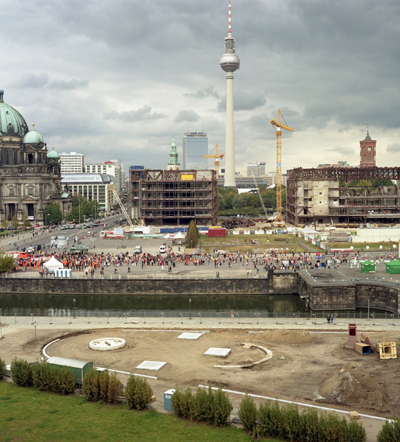Click for slideshow Palast 2007
![]()
Just as New Yorkers are scrutinizing the development of the World Trade Center site, Berliners are scrutinizing the development of the Palast der Republik site. The Palast, an immense, East German government building completed in 1976, was condemned for asbestos in 1992 and demolished from 2006 to 2010. Located along the River Spree, amid stately nineteenth century buildings, at the very heart of Berlin’s cultural and tourist district, it had become, after the wall fell in 1989, a very visible symbol of all the wrong things: communism, oppression, censorship, and very, very bad style. A long, low concrete slab covered with gold mirrored glass, it looked like a flashy high security prison. Inside, it housed administration spaces for the city’s communist government and public spaces (lounges, bars, cafes, a bowling alley) where citizens could socialize in state-sanctioned splendor. The interiors were finished in the style of the time, with shag carpets, colored wallpaper, and chrome chandeliers studded with globe lights.
To replace the Palast the city chose to reconstruct the shell of the eighteenth century castle that previously occupied the site, which was damaged during World War II and demolished in 1950. This new castle will house a museum, a library, and shopping mall. It’s a brazen act of historical amnesia, one that looks past an unattractive chapter in history to one that’s more palatable. The project, which was suspended for financial reasons, is slated for completion in the next decade. Just last month a temporary structure, with exhibition space and a lookout point for tourists, opened at the site.






 Facebook
Facebook Permalink
Permalink Digg
Digg Reddit
Reddit LinkedIn
LinkedIn StumbleUpon
StumbleUpon Tumblr
Tumblr
